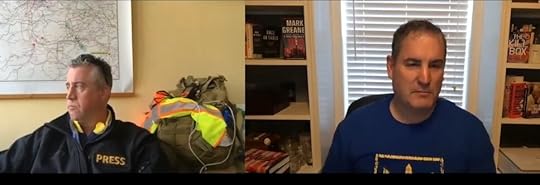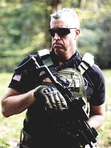WZD#8 – Russian Nukes & Chem
War Zone Diaries#8 – Russian Nukes & Chem
BLUF: I don’t believe Russia will use strategic nuclear arms. Tactical nukes and chem may be a different matter. Read on for additional analysis.
I did a very in-depth discussion with the guys over at Crew Reviews. They were nice enough to let me ramble on about all manner of things Ukraine including the topic of nuclear weapons in Ukraine. Below is my written version, and expansion on the topic. What makes me qualified to answer this question? I was the Nuclear Arms Officer for the U.S. Marine Corps in the Pentagon. Are there more qualified people than me to answer this question? Most certainly. That said, however, I am decent at writing and communicating tactics and strategy to civilians, so what follows is an 8-minute experience that’s free to you and breaks things down in laymen’s terms more than your average PhD nuclear physicist’s have done on the interwebs.
Right off the top, this is a very morbid topic. The conversation deals with the possible deaths of millions of people if the conflict spreads in Ukraine and even beyond. So, like many of my diary reports, tune out if you need a break from war. Though, there is some good news here too.
I don’t believe Putin is dumb enough to use strategic nuclear weapons unless Russia, meaning the actual Rodina (Motherland) is directly threatened. However, there are some fundamental problems to this argument. Russia has it’s back against a wall: Russia’s economy is in a free fall and will take years to recover; Russia is not losing the war, but they are not winning either; Putin will not allow Russia to lose this war. So, you know what they say about a cornered rat. But mostly, and this is what I will focus on, Russia views tactical nuclear weapons very differently from the United States and the West.
The U.S. and Russia have made immense progress in the elimination of strategic nuclear arms. At it’s peak, Russia had 39,197 strategic nuclear devices. This includes bombs, submarine and ground-based Intercontinental Ballistic Missiles (ICBMs), and cruise missiles. The United States had 31,149 and included the same variety.* Strategic arms reductions talks and treaties, SALT I, SALT II, START and New START (of which I had a minor role), were all aimed at reductions in stockpiles, and for the most part succeeded. The U.S. has reduced it’s stockpile to 5,800 and Russia reduced to 6,375 with even more reductions on their way. It’s important to note that even this level of nuclear weaponization can destroy hundreds of millions of lives on first impacts and eventually will result in the deaths of billions through fallout and contamination.
This brings us to the war in Ukraine and the problem with Russian nuclear weapons stockpiles. The largest issue is that Russia and America’s perspectives on these weapons differ drastically. Russia has had, and continues to store, tactical nuclear weapons. These are weapons that are as small as an artillery shell and as large as a bomb that can be carried by a joint role fighter (50-100lbs). What’s the difference, you may ask. The difference is that the West has never really asked Russia to account for this stockpile. Instead ceding the point that if Russia felt a direct threat to the Rodina, they might defend themselves not with a full strike against the U.S. and Western capitols, but against the fighting and field forces of their opponent’s armies. The munitions themselves are considered “theater level weapons,” and generally speaking, cannot be projected outside a military theater. This means that the missile/bomb/torpedo/depth-charge/artillery shell itself is incapable of crossing an ocean, but is fully capable of firing from Belarus into Ukraine for example.
There’s a second issue with this perspective. Russia sees these “theater level” or “tactical level” nuclear weapons as just a very big bomb. They have never fully acknowledged the effects of fallout or nuclear contamination. Certainly not the long term effects on an ecosystem, food, plants, water, animals or even really humans. It is, to use Orwellian terms, very much Duckspeak or Doublespeak. That is to say, the science concerning the effects of radiation are well known in Russia, but the use of terms to describe the effects of tactical munitions have been intentionally obscured in their manuals and training so officers in the military that might be called upon to use the weapons are left in the dark, or better defined, cajoled into believing that the effects are as limited as say, the blast radius of the weapon itself. You would have to go out of your way as an officer in their nuclear artillery military occupational field to understand the true effects of a tactical nuclear weapon.
Putin himself was the part-author to a type of limited nuclear weapons use he called “Escalate to de-escalate.” This term is as terrifying as it sounds, and though it fits well into the Russian propensity to posture greatly with policy but not necessarily follow through with use, it is still a very real part of the Russian military’s orthodoxy. The core of the concept from then-secretary of Security Council of Russia, Putin, “using both tactical and strategic nuclear threats and strikes to de-escalate or cause an enemy to disengage from a conventional conflict threatening what Russia considers a strategic interest.”** Yes, this very much means what it says: use a nuclear weapon to win, and thereby scare it’s opponents so heavily from using their own weapons or continuing the conflict that they will sue for peace.
Yeah, it’s insane.
So what’s the result? The result is that Russia still has a stockpile of chemical munitions and most concerning still has an ardent perspective on the use of small nuclear devices – if till now only to convince the world that it takes threats to its existence to the max. The result of which is that there is a slim, but unlikely chance that Russia will use small nuclear weapons if and when it feels that the scales of the war are tipping out of their favor.
Should we be concerned? Yes. Simply, yes. As early as today, Russia has experienced losses in and around Kyiv. The cities of Irpin, Lisne, Motyzhyn, Kapytanivka and Dmytrivka have been liberated and are now under control of Ukrainian forces. I have spoken and interviewed fighters who have been in combat there (I’ll link the article later, but you can see some of their stories on my Twitter) and I will say there is not a lot left of those towns and hamlets. However, this is war, and those are very real reversals, and Russia, although not losing, certainly is not winning.
What will happen? I don’t know. But I know Putin is the worst Hitler since Hitler, is a megalomaniac and is a very unstable dictator. The threat of nuclear weapons and fallout to Ukraine and Eastern Europe is very real. The West needs to continue to support Ukraine in their fight for existence, but also be forewarned that a failure to stop Russia can lead to much larger consequences.
*https://www.sipri.org/media/press-rel...
**https://thebulletin.org/2014/03/why-r...
The post WZD#8 – Russian Nukes & Chem appeared first on Rip Rawlings.
Tactical Talk
- Hunter Ripley Rawlings's profile
- 93 followers




